Matcha is a type of green tea with a rich, earthy texture and a slightly sweet flavour. Brewing this delicious beverage is an art form in itself. So, if you want to make it in the comfort of your home, why not try our Japanese green tea recipe? We learnt the art of brewing the perfect cup through Japanese tea ceremonies in Japan.
In our guide, we'll show you two preparation methods. The first method is a simplified version using everyday kitchen tools. The second method is a more traditional method that requires specialty tools. We’ll also give you some essential tips to master how to make matcha tea at home.
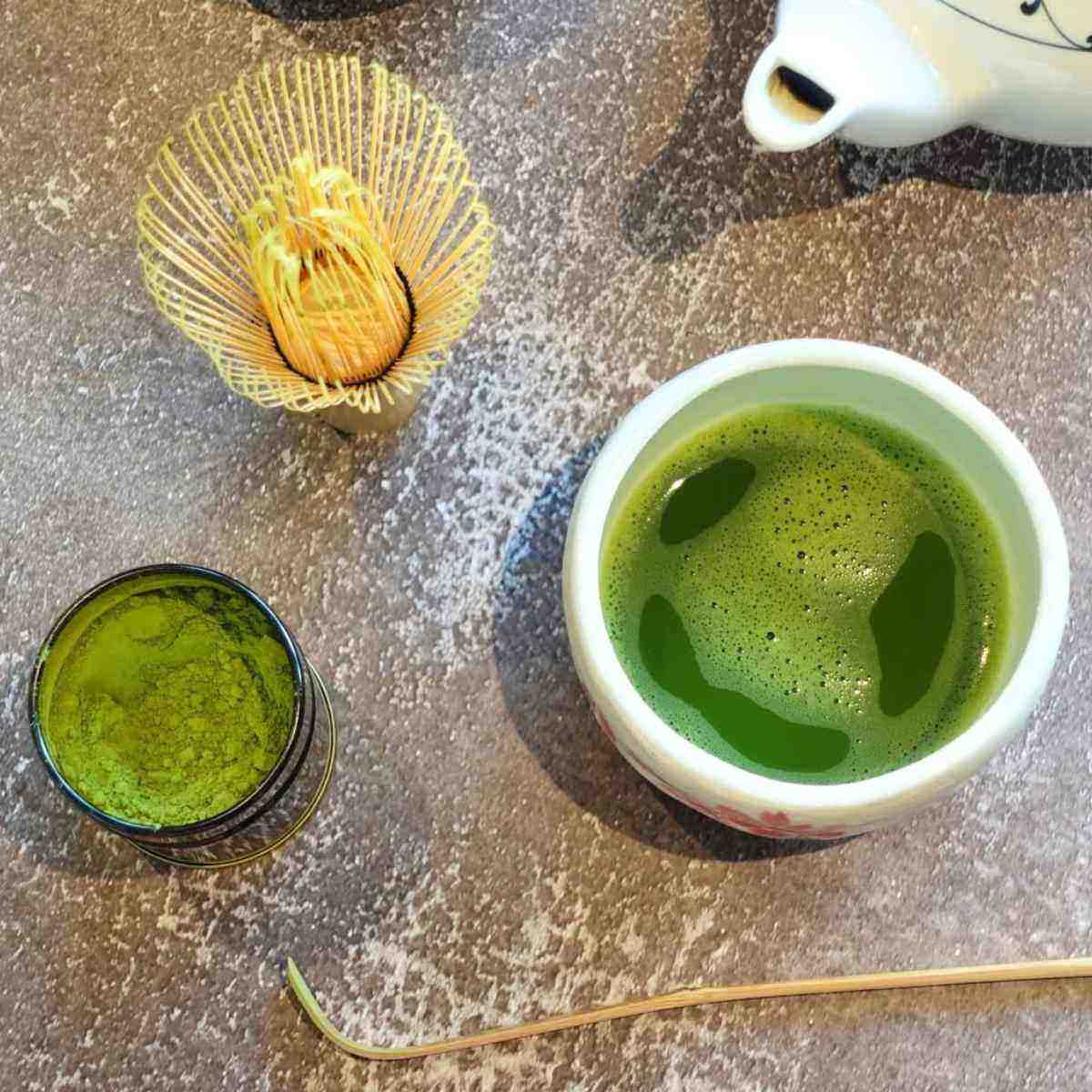
Jump to:
- What is matcha?
- Preparing matcha green tea
- How to Make Matcha (Japanese Green Tea at Home)
- Tools to prepare matcha tea
- Making matcha green tea (traditional method)
- How to make matcha tea (no speciality tools)
- Preparing green tea beforehand
- How to drink and serve Japanese green tea
- Health benefits
- What does matcha taste like?
What is matcha?
Matcha is a type of Japanese green tea made from the powdered tea leaves of the Camellia sinensis plant. The leaves are harvested, steamed, dried, and ground into a fine powder. While tea makers brew most teas from steeped leaves that are then filtered out, matcha tea includes the whole leaf in its powder.
Preparing matcha green tea
To prepare matcha, you need green tea powder and water, with optional milk and sweetener.
Matcha powder
There are two types of matcha powder you can use for making Japanese green tea. These are ceremonial grade and culinary grade.
Ceremonial grade has a refined, delicate texture and a mild taste. Ceremonial-grade tea leaves are specifically grown, harvested, and processed for traditional Japanese ceremonies.
It is best to use ceremonial-grade powder for making Japanese green tea due to its delicate taste and texture. When you’re making matcha, we recommend using approximately ¼ to ½ teaspoon of powder per cup of water.
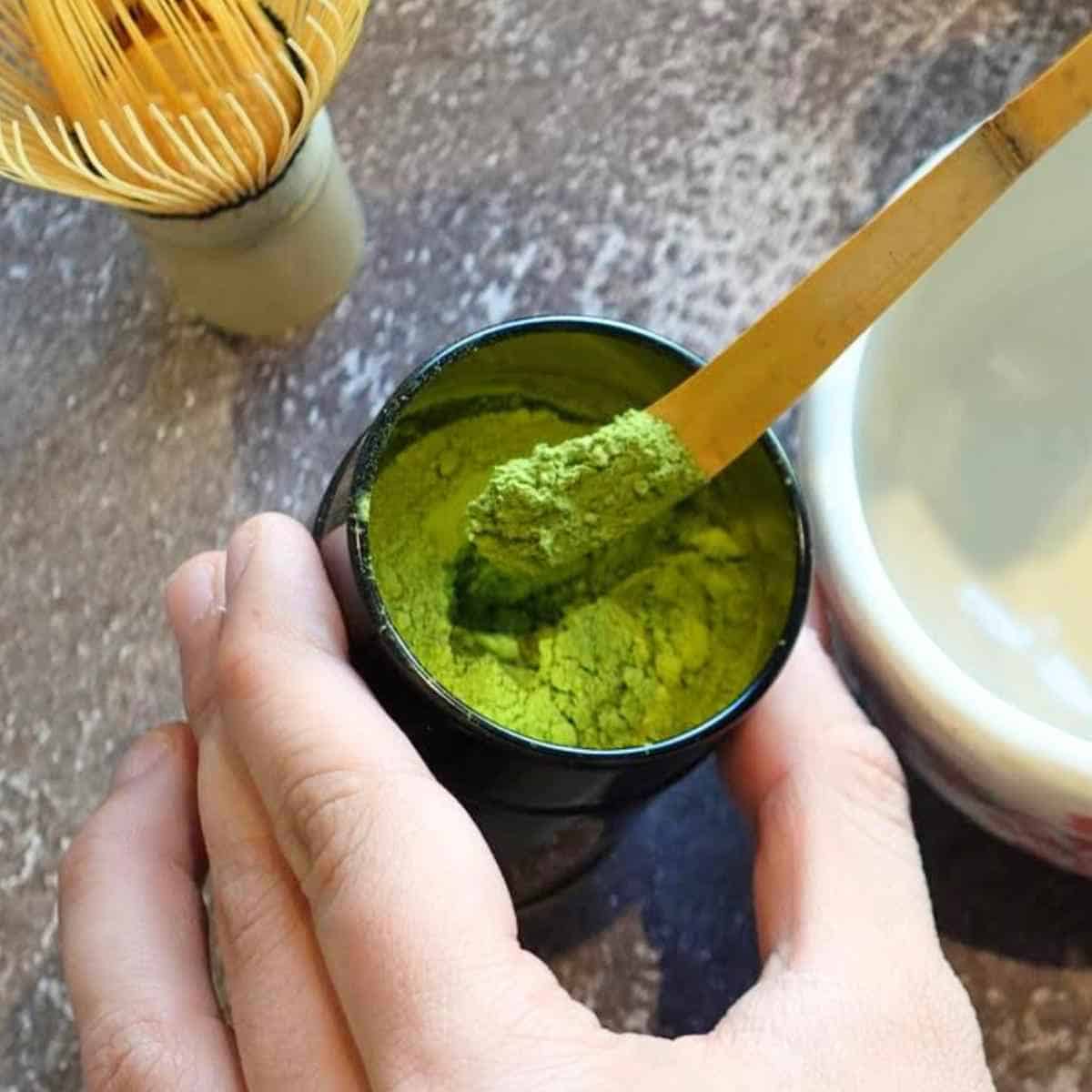
You can also use culinary-grade powder as a substitute. However, the resulting taste and texture will be different from the ceremonial grade. Typically, the culinary grade has a more robust flavour than the ceremonial grade. It is also less expensive and more widely available.
If you choose culinary-grade powder for the matcha recipe, here’s what you need to know. Culinary-grade powder is usually less vibrant in colour and more coarse. This means it can have a more gritty texture and be slightly bitter. This taste may be less appealing to those used to ceremonial-grade’s smooth and mellow taste.
| Differences | Ceremonial | Culinary |
|---|---|---|
| Taste | Refined and delicate | Robust, slightly bitter |
| Texture | Smooth | Gritty |
| Purpose | Drinking | Cooking |
Therefore, our Japanese Green tea recipe uses ceremonial-grade powder.
Nonetheless, it is still a good choice if you want to enjoy the benefits of this Japanese beverage without breaking the bank.
Water
We recommend you use water that is approximately 80°C(175°F) in temperature. You can use cooler water with a minimum temperature of 60°C(140°F). However, do not use water hotter than 80°C(175°F). If the water temperature exceeds 80°C, you will end with a bitter and unpalatable drink.
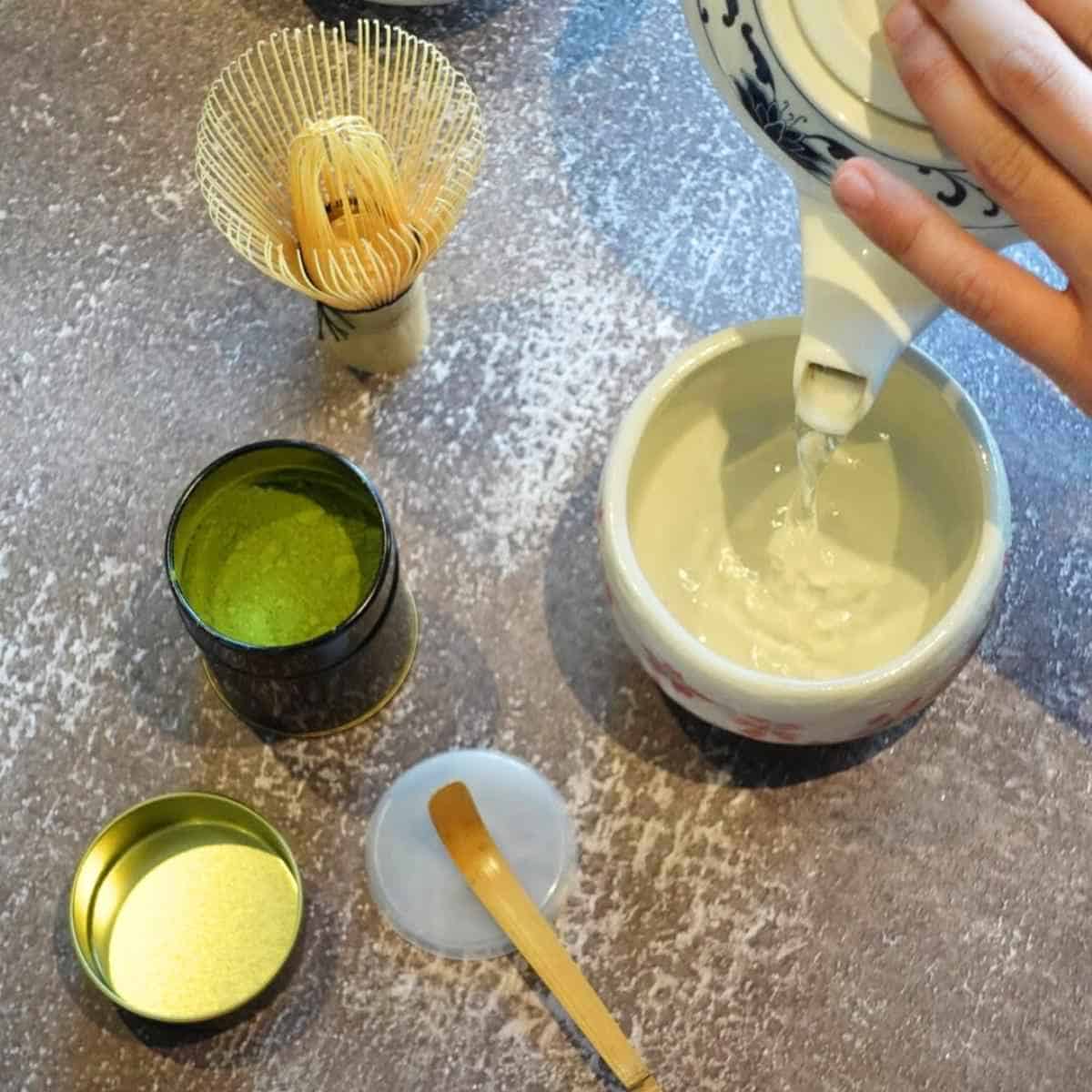
You will need about 100 ml of water per ½ teaspoon of powder. Our matcha recipe uses 60 ml water per ¼ teaspoon of matcha powder. You can also use less water for a stronger drink.
You can also use high-quality water, such as spring or filtered water. This will help you avoid any unpleasant flavours of hard tap water when making matcha green tea.
Milk (Optional)
Milk is optional for our Japanese Green tea recipe. Traditional matcha does not add milk, but if you add milk, you’ll make a matcha latte instead. The latte is a delicious and creamy beverage that can be enjoyed with or without milk.
If you prefer a creamier texture, adding milk is a great option. We love using a milk frother to add the milk in.
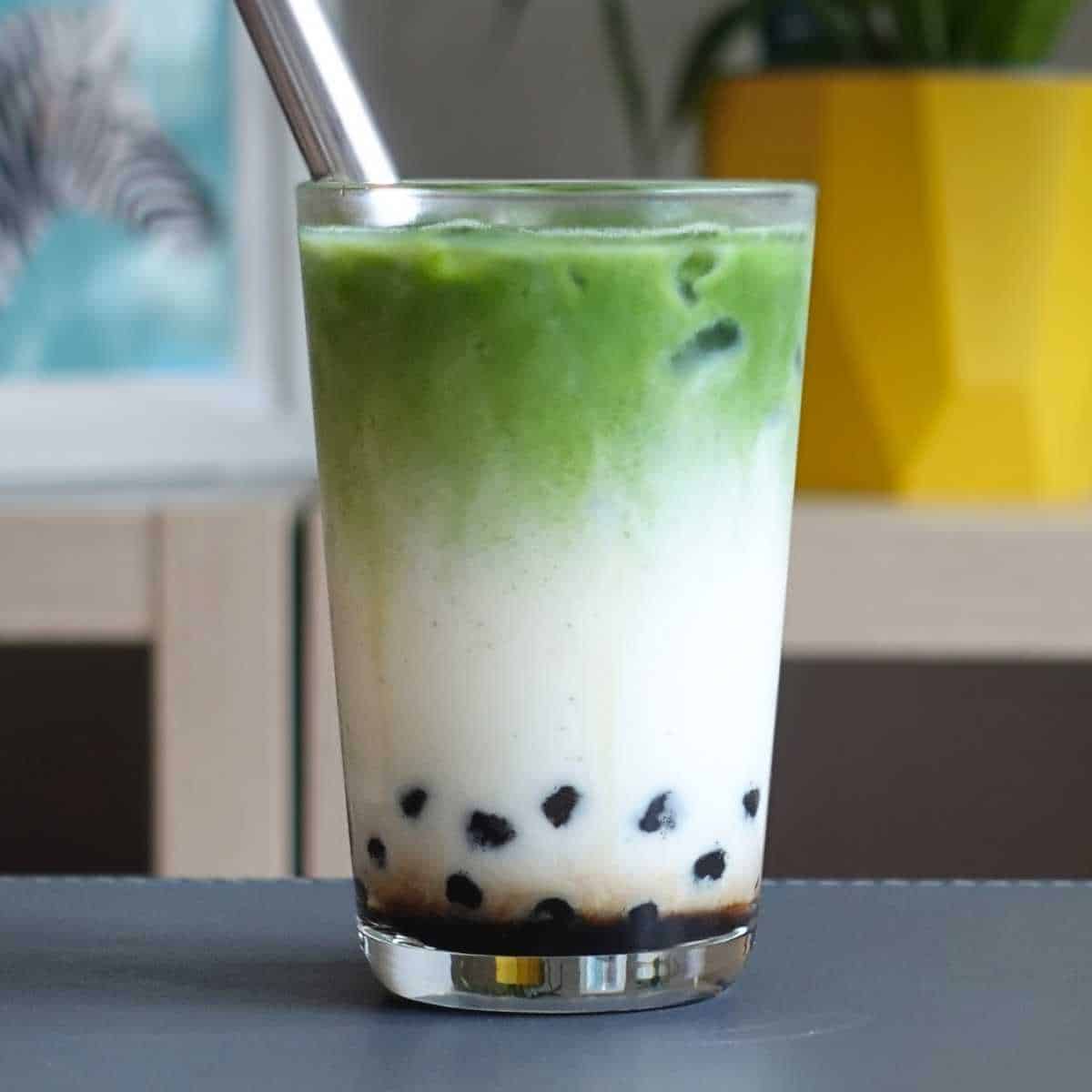
You can use any type of milk, but full-fat milk will produce a richer and creamier latte. Semi-skimmed milk gives you a lighter latte.
Non-dairy milk options like soy, almond, coconut, or oat milk are also great alternatives. These plant-based options create a sweet, creamy, nutty flavour that goes well with matcha.
Our preference is to use soy milk, oat milk or coconut milk. These types of plant-based milk enhance the overall taste of the drink. You can still taste the unique flavour of the tea leaves and aroma, creating a delicious and satisfying beverage.
Sweetener (Optional)
Adding sweeteners to any simple matcha recipe is not a traditional practice. However, some people find Japanese green tea's natural bitterness too intense. So, adding a sweetener is now very common in Western countries to balance the flavour when making Japanese green tea.
You can use honey as a natural sweetener to add to your warm Japanese brew. It adds a slightly floral flavour that complements the grassy matcha taste.
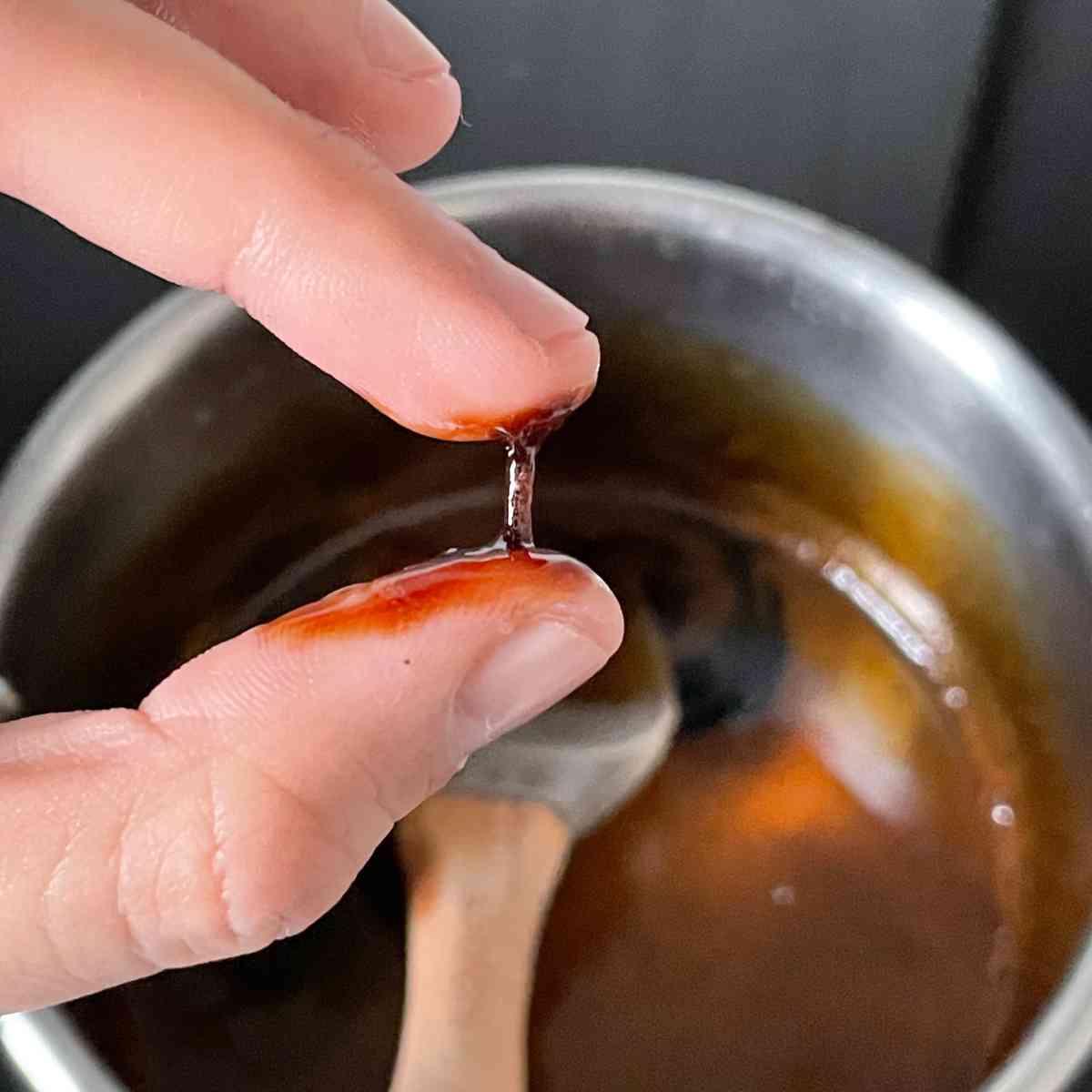
Another option is agave nectar. It is a sweetener that people commonly use as a substitute for sugar. It has a milder flavour than honey and can be used to sweeten your drink. We also like how it does not alter the taste too much.
Finally, putting plain old granulated sugar also enhances the drink. However, we tend to avoid this as you can easily overpower the flavour of the tea.
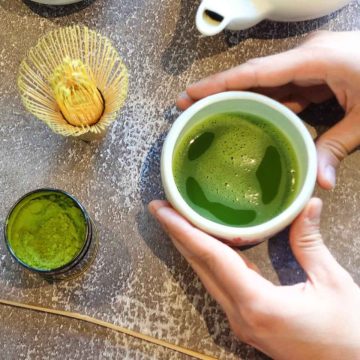
How to Make Matcha (Japanese Green Tea at Home)
Video
Ingredients
- ¼ teaspoon matcha powder
- 60 ml hot water
- sweetener
Equipment
Cooking Instructions
- Add hot water (around 80°C/176°F) to your tea bowl. Use the whisk to dip into the bowl and preheat it, along with the tines of the whisk. Wait for about 8-10 seconds. Set the whisk aside, discard the water, and wipe the bowl dry with a clean towel. If you don't have a tea bowl or tea whisk, skip to next step.

- Take 1 to 2 scoops of matcha powder using the chashaku (bamboo scoop) or a teaspoon. Gently add the powder to the bowl, tapping off any excess powder.
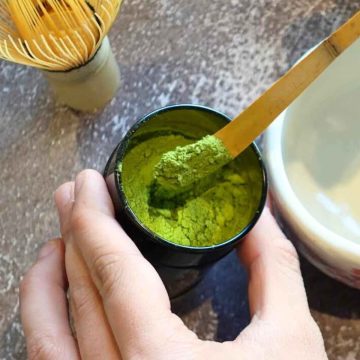
- Pour 60ml of hot water (around 80°C) into the bowl. Hold the bowl with one hand and the whisk with the other. Whisk the tea quickly and vigorously in a back-and-forth motion for 15-20 seconds, forming a frothy and creamy layer on top. After whisking, tap the whisk on the edge of the bowl to remove excess tea and enjoy your matcha.
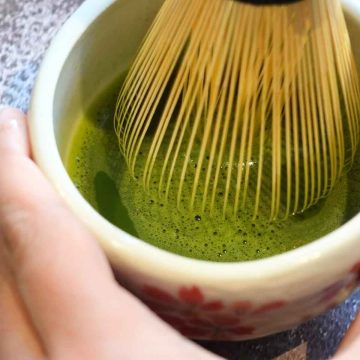
Recipe Notes
Nutrition
Calories have been calculated using an online calculator. Nutritional information offered on Honest Food Talks is for general information purposes and is only a rough estimate.
Tools to prepare matcha tea
When it comes to preparing green tea in the traditional way, several tools can help you. While they are optional, they can improve the taste and texture of the drink. It also enhances the experience of making Japanese green tea. Here are some of our favourites.

Chasen (Tea Whisk)
Chasen, a tea whisk, is a traditional tool used in Japanese tea ceremonies. The Japanese like to use it for making Japanese green tea as it helps the powder evenly dissolve in the water.
The Japanese craft the tool from bamboo, with many fine tines which produces a smooth and creamy texture. The whisking action also introduces air into the mixture, giving you a frothy and appealing appearance.
Although using a bamboo whisk can be tiring for beginners, we think the results are worth it. If you use this with the correct whisking motion, you’ll get a lovely creaminess to the drink without adding any milk.
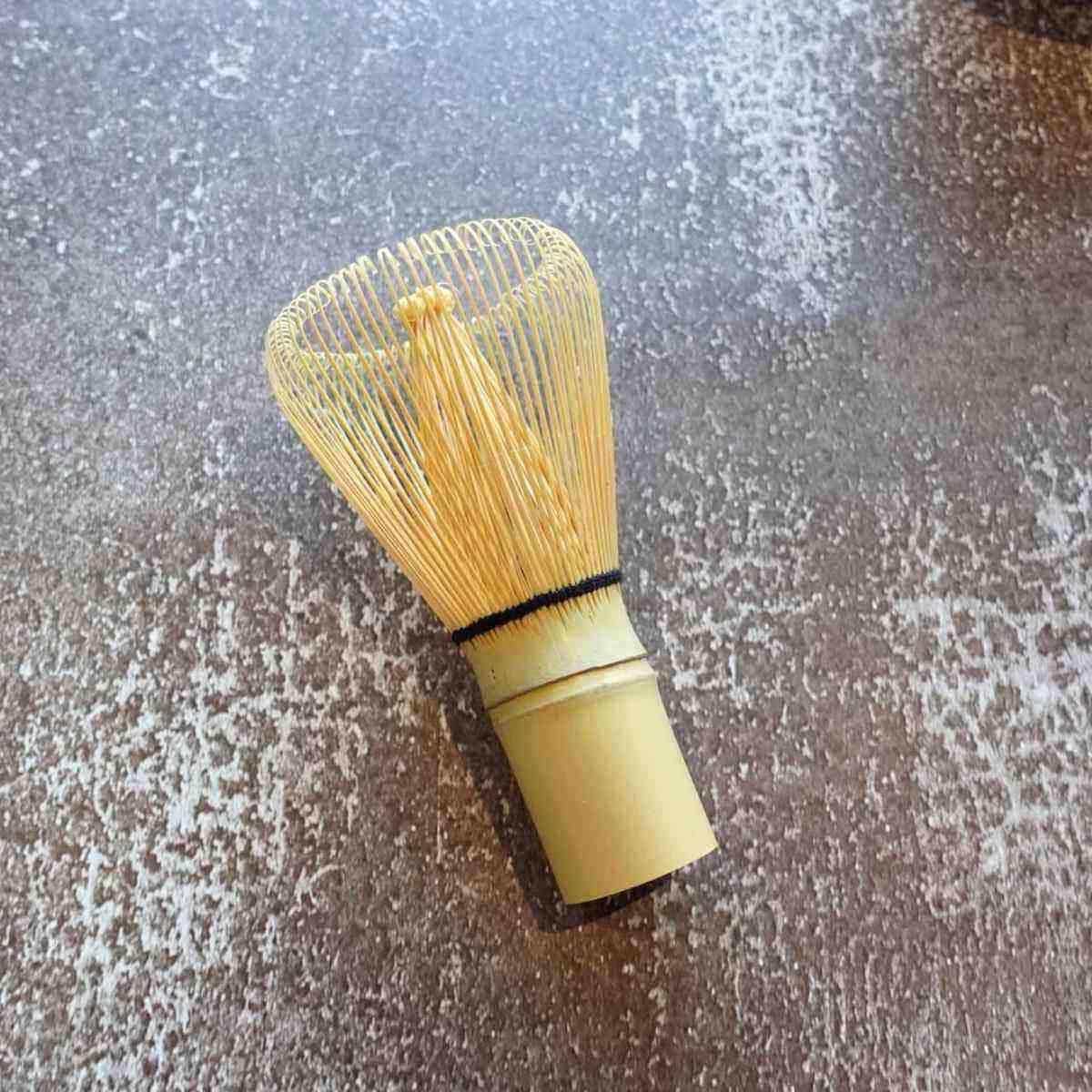
While an electric milk frother can be an excellent alternative to a chasen, it may not produce the same frothiness that a chasen can achieve. However, you can still use it for your Japanese Green tea recipe.
If you don't have a chasen or frother, you can also mix the powder using a fork or spoon with a fine mesh strainer. First, sift the powder through the strainer to break up clumps. Then, stir vigorously with hot water over the powder using a fork or spoon. Stir until you have fully dissolved the powder and the mixture is frothy.
Chawan (Japanese Tea Bowl)
Chawan is a traditional Japanese tea bowl for making and drinking this delicious Japanese beverage. It is typically made of ceramic. The bowl is wide and shallow, with a small foot at the bottom.
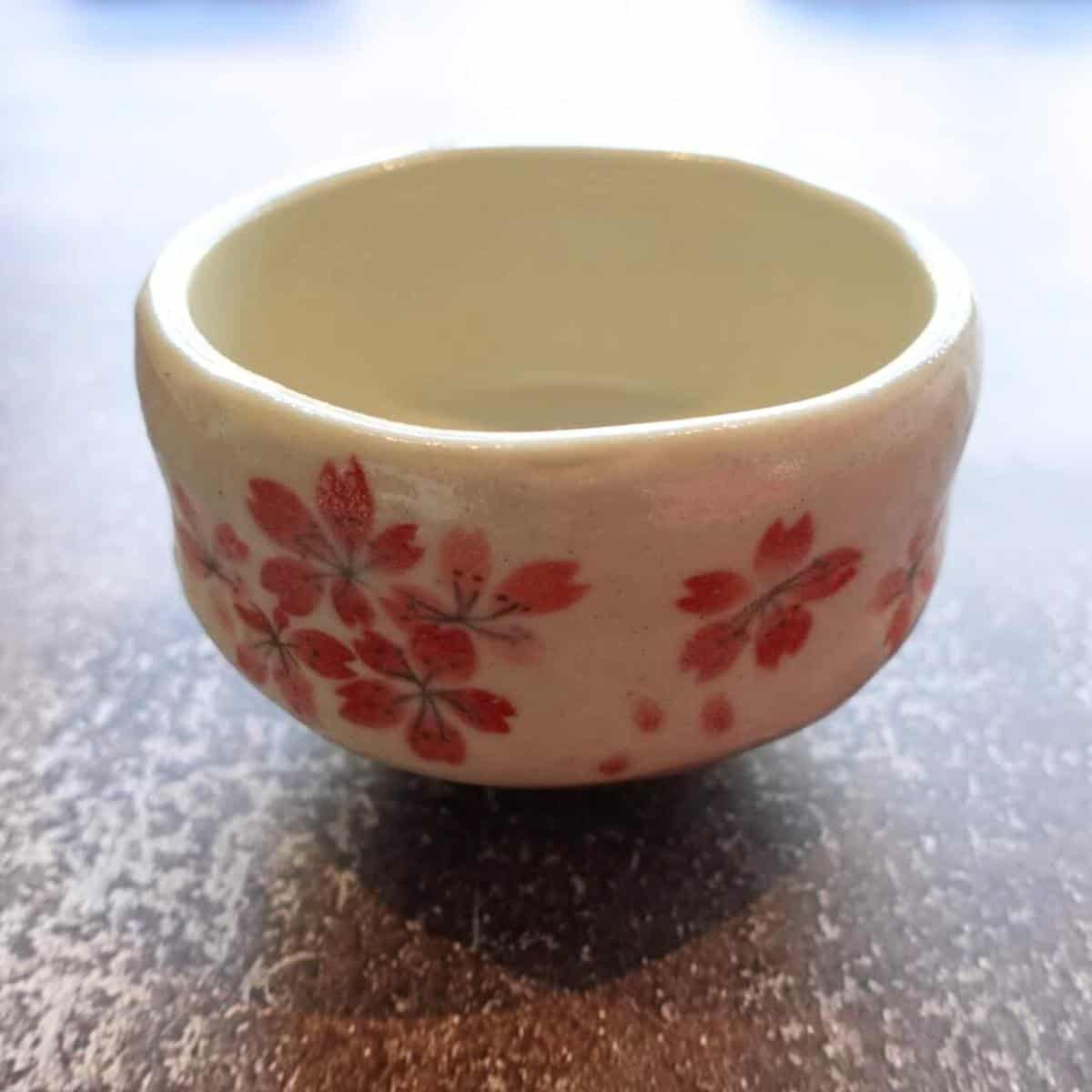
Using a chawan can help improve the whisking of the drink. It provides a wide surface area for the chasen to move around and create a frothy texture. The shallow shape also allows the drinker to experience the aroma and colour of the drink thoroughly.
If a chawan is unavailable, use a wide and shallow cup or bowl with a smooth interior surface. Choosing a shape that allows for easy whisking and drinking of the tea is essential. The overall appearance also has to be aesthetically pleasing to the individual.
Chashaku (Bamboo Scoop)
Chashaku is a traditional Japanese bamboo scoop that measures and transfers powder. It is helpful when you are following the serving sizes of the matcha recipe. It is typically made from a single piece of bamboo and has a curved shape.
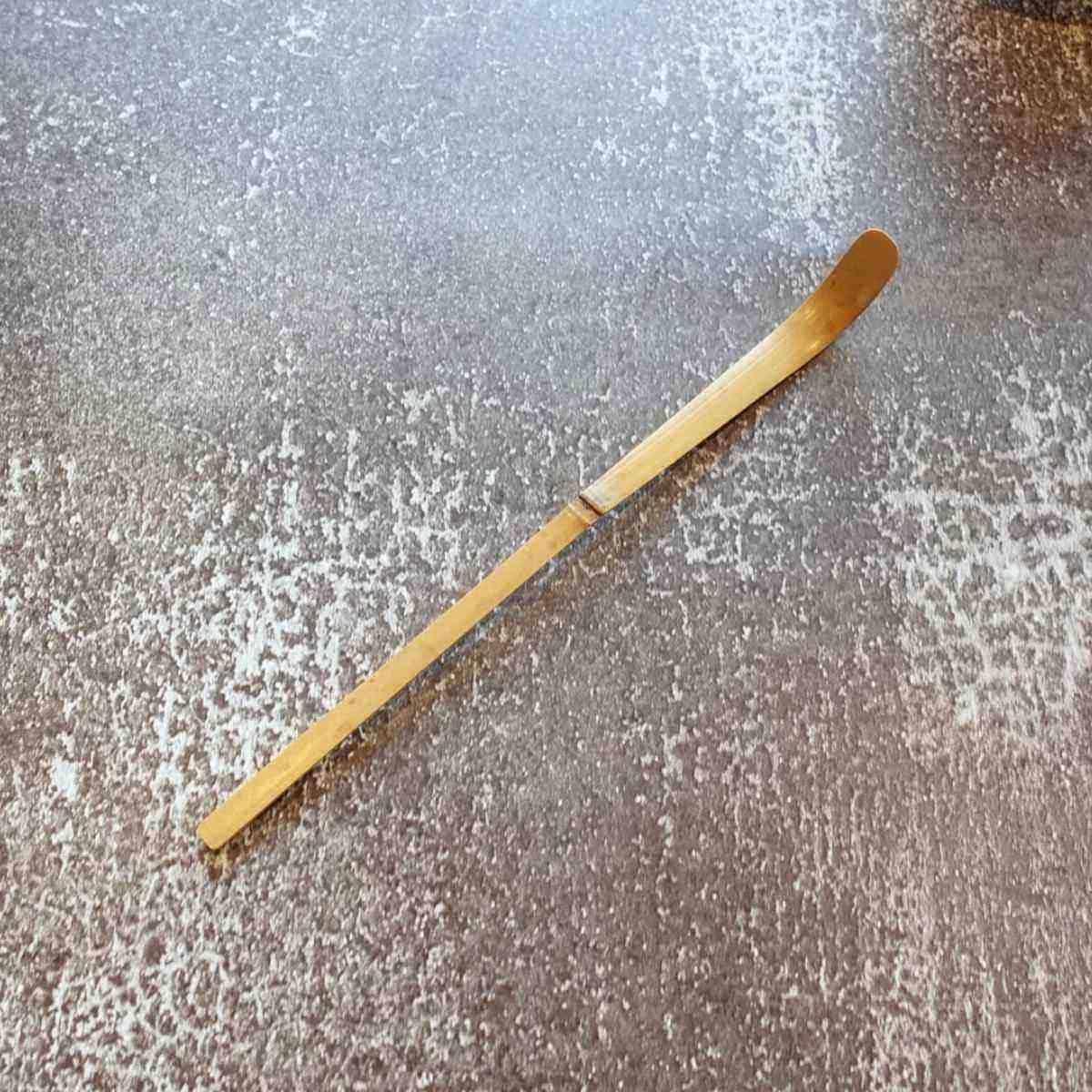
Using a chashaku can help improve the drink by ensuring you use the correct amount of powder. The scoop's curved shape allows for consistent and precise measurement of the powder, preventing the user from accidentally over or under-scooping.
The smooth surface of the bamboo scoop also helps prevent the powder from getting stuck and wasted on the utensil.
In addition to its practical benefits, using a chashaku can enhance the overall experience of brewing this Japanese beverage. It adds a touch of traditional Japanese culture to the process.
Making matcha green tea (traditional method)
Here are the steps to make matcha at home using the traditional method.
Start off by adding hot water to your chawan (tea bowl). You should make sure that the water is not boiling hot but is around 80°C (176°F).
Then, take your whisk and dip this into your tea bowl, to help preheat both the tea bowl and the tines of your bamboo whisk. Preheating your tea bowl that is made out of clay will help it not absorb less heat while you’re whisking matcha tea later on.
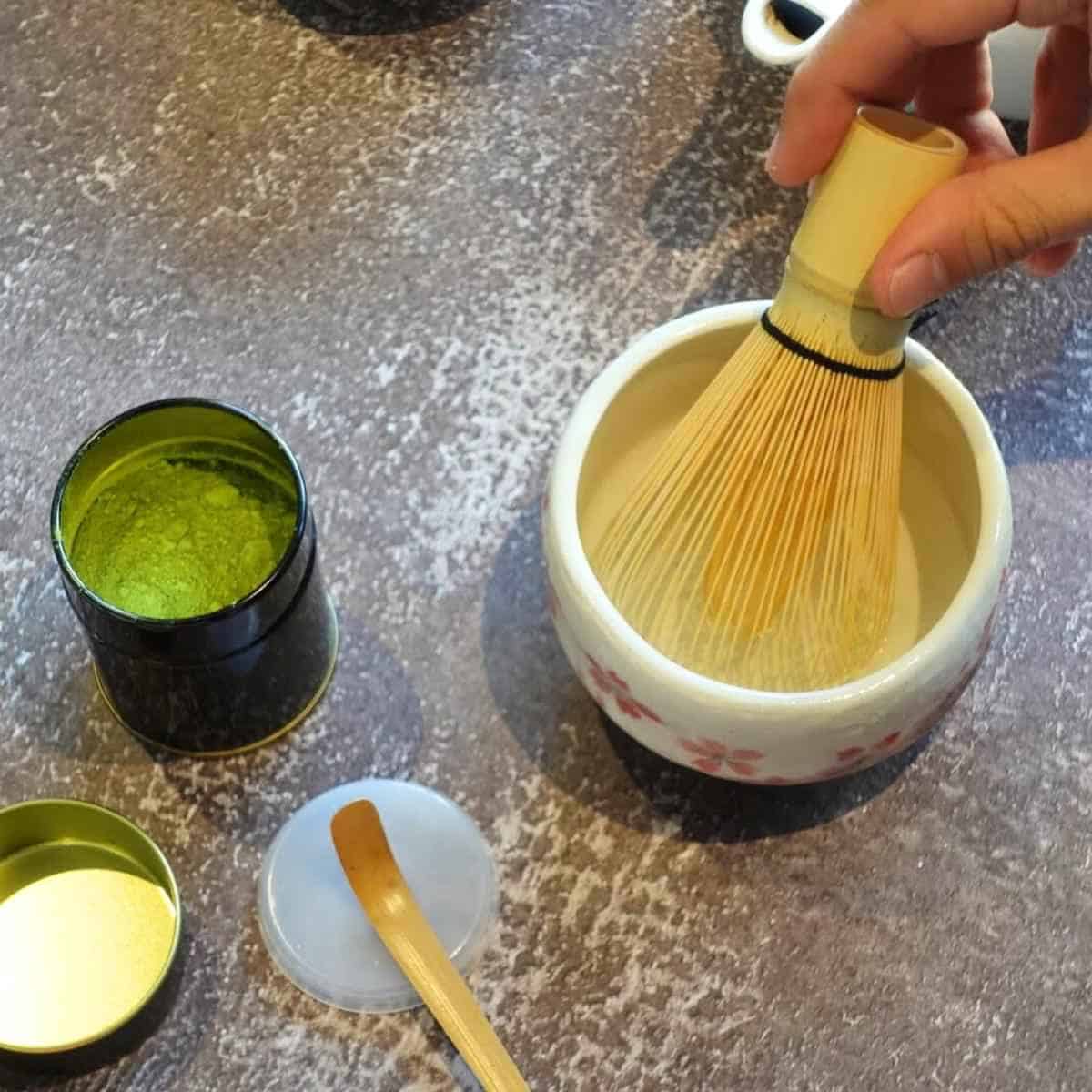
Give this about 8-10 seconds before setting your bamboo whisk aside and discarding the water in the bowl. Now wipe the bowl dry with a clean towel or paper towl.
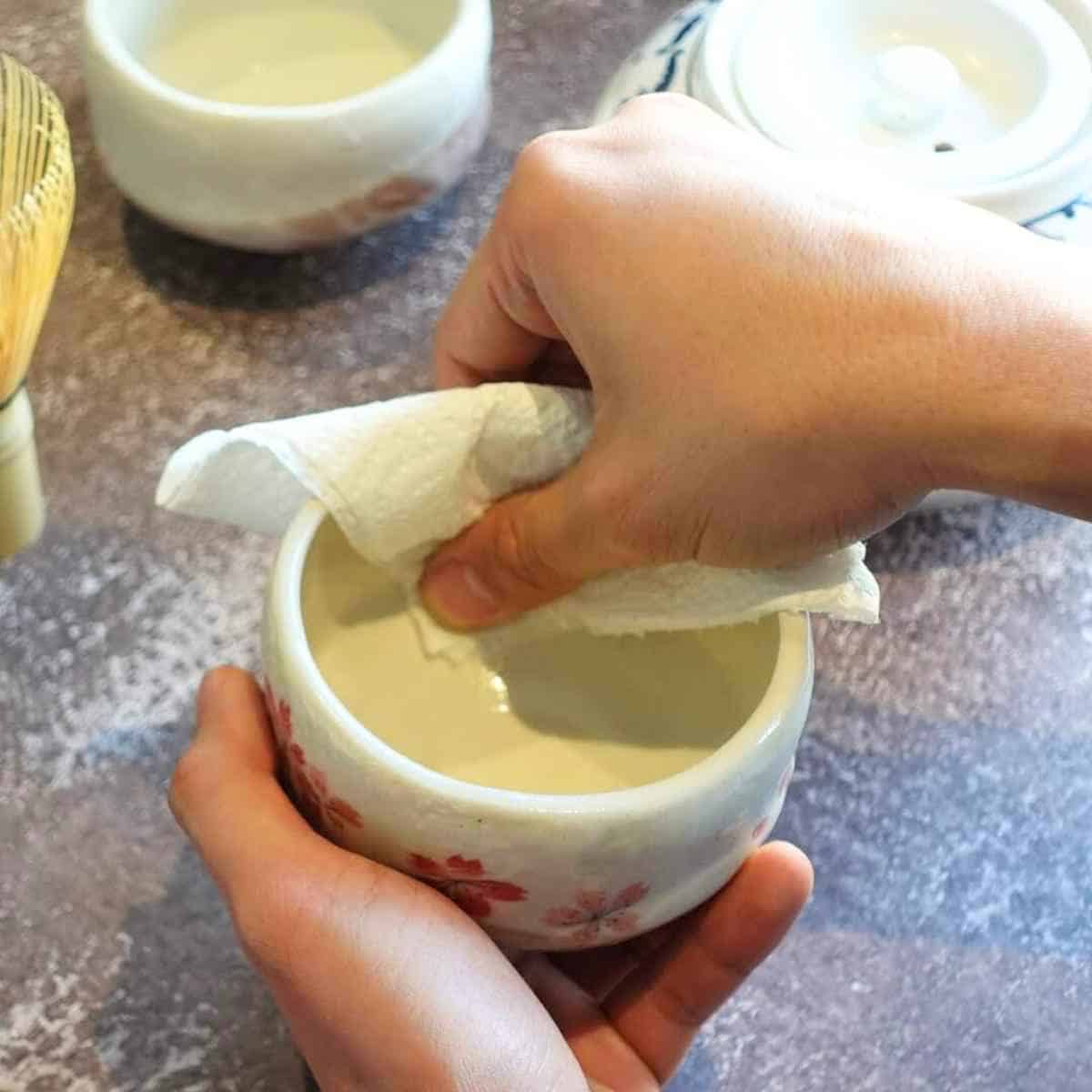
Using your chashaku (bamboo scoop), gently take out 1 to 2 scoops of powder and add it to your bowl. If there is any excess powder on your bamboo scoop, you can gently tap this on your bowl.
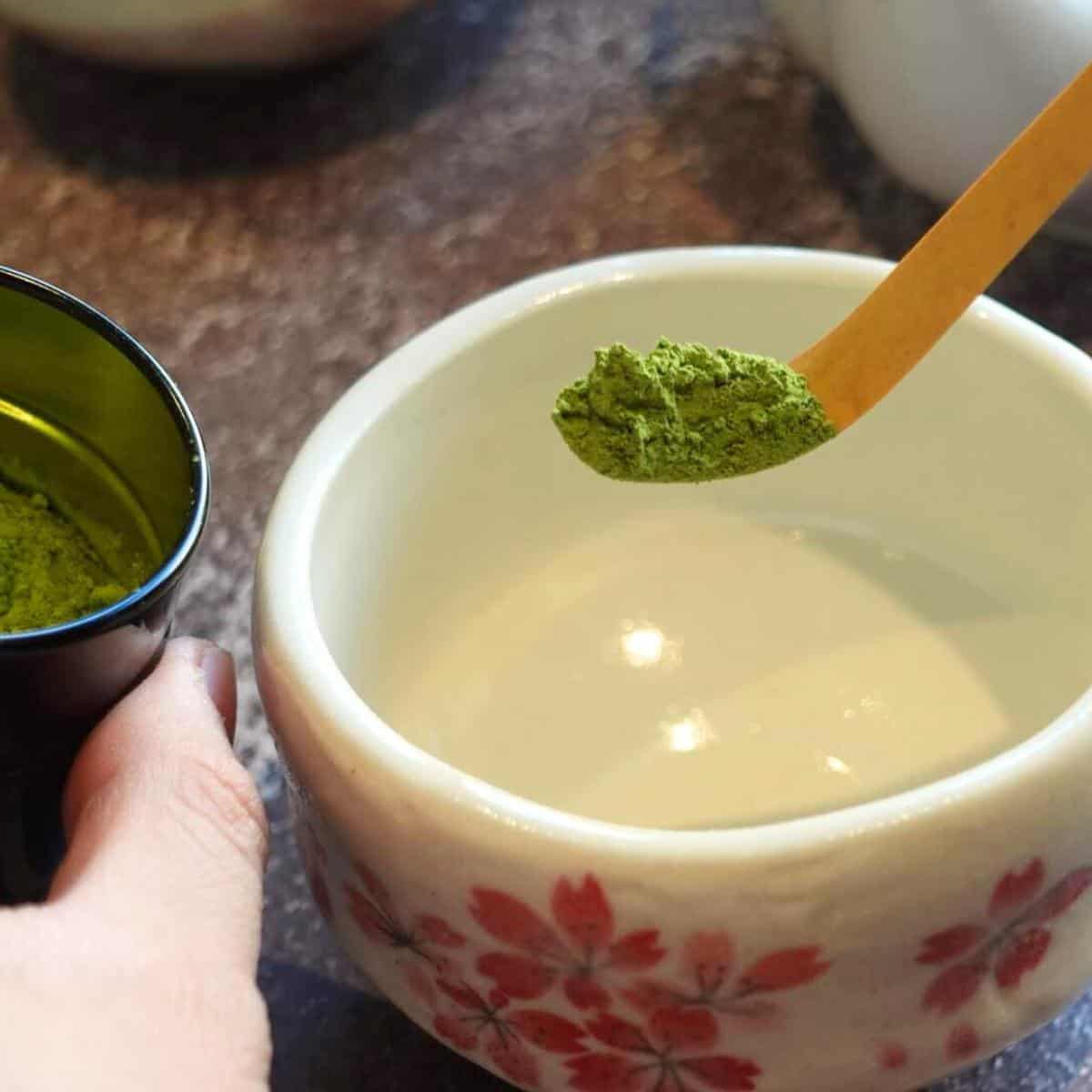
Now, pour 60ml of hot water that is around 80°C into the tea bowl. Hold the bowl with one hand and the bamboo whisk with the other.
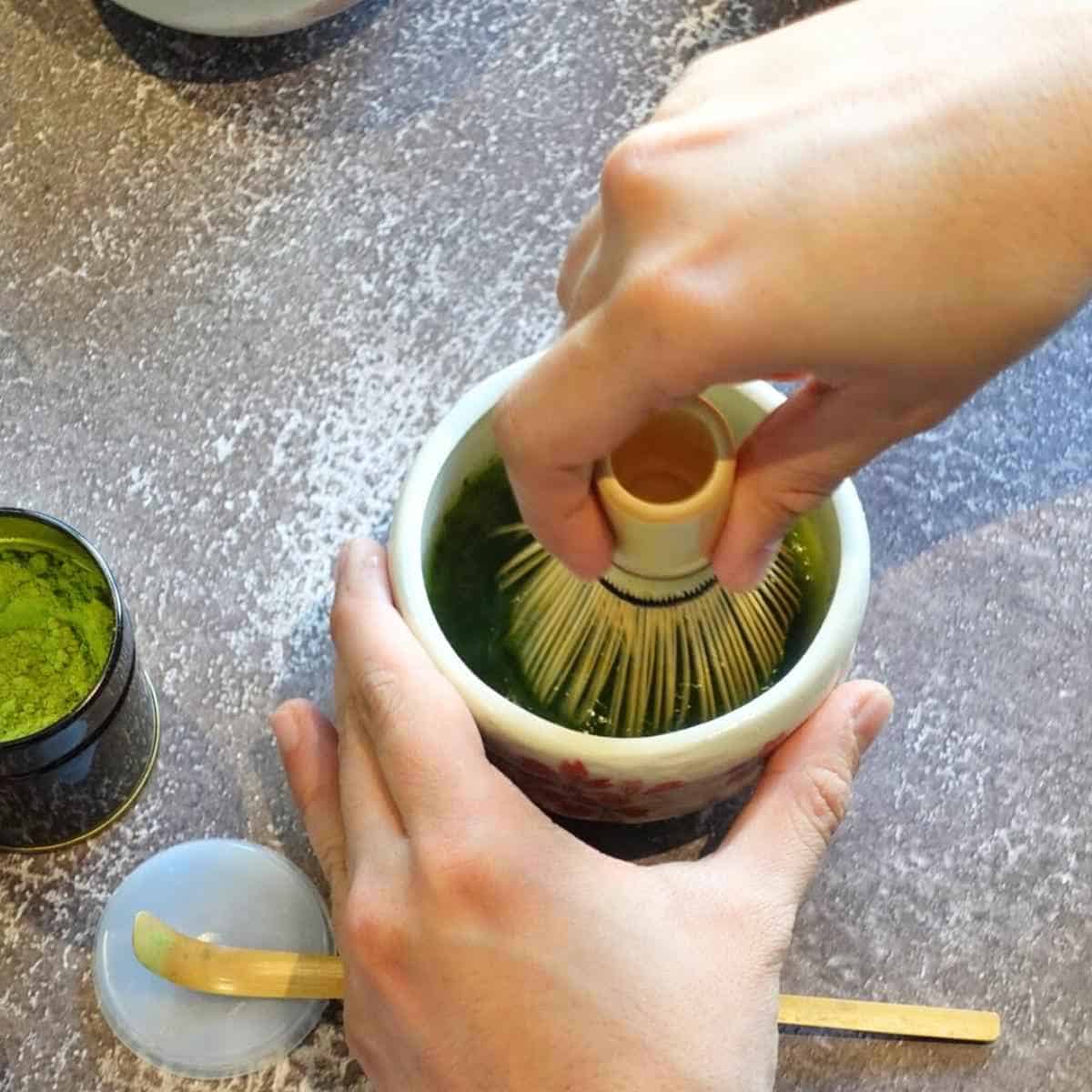
Use a back-and-forth motion to whisk the tea quickly and vigorously for about 15-20 seconds until a frothy and creamy layer forms on top of the tea. When you’re whisking the powder, use a gentle yet fast back-and-forth motion with the bamboo whisk. To create a smooth and frothy texture, you should do the whisking in a "W" or "M" shape rather than a circular motion.
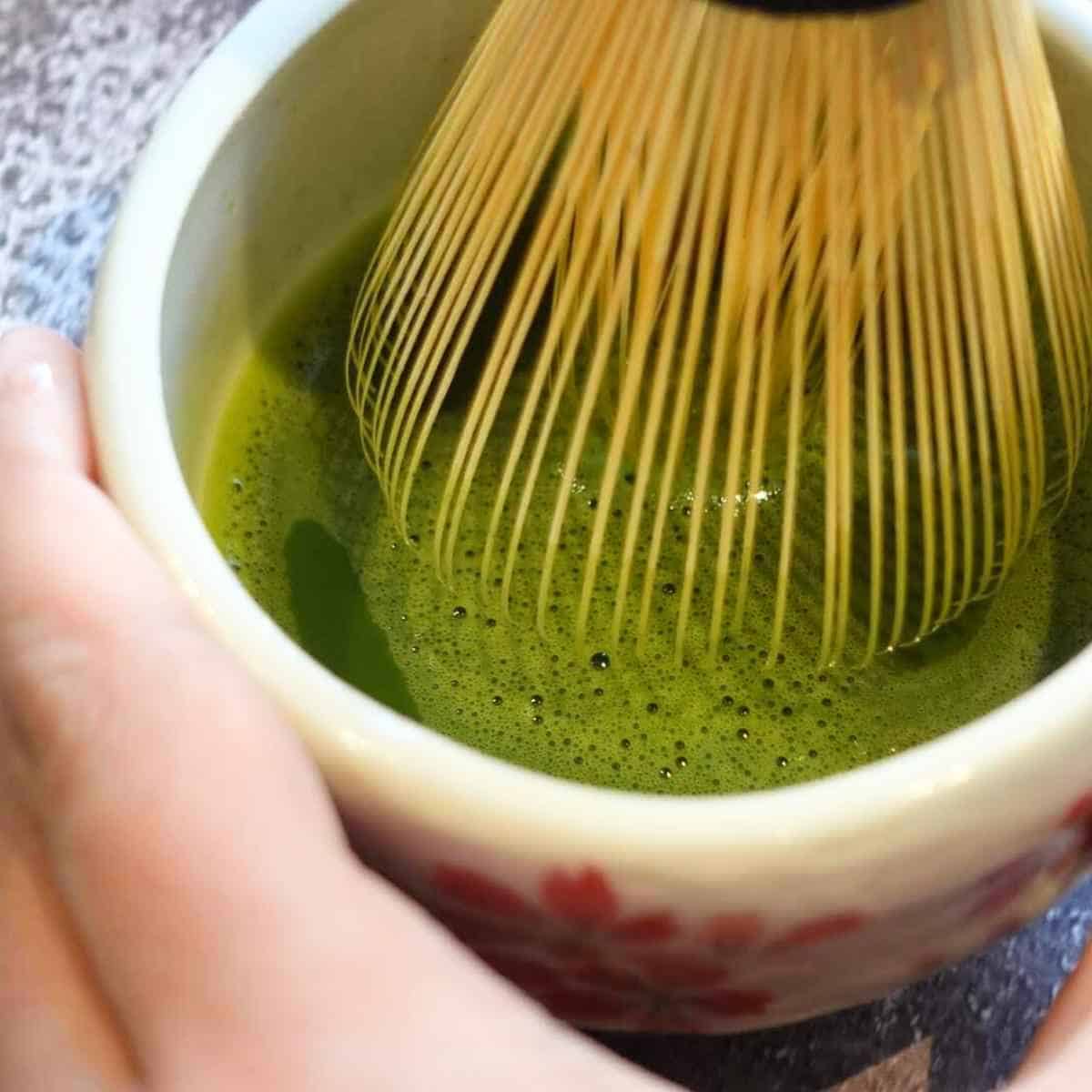
The time required for whisking in this matcha recipe is 15-20 seconds. Then, you will achieve the desired frothy texture. Once you have finished thoroughly whisking the tea, gently tap the whisk on the edge of the bowl. This step can remove any excess tea from your tool and reshape the tines.
How to make matcha tea (no speciality tools)
All the specialty tools mentioned above can be hard to find and expensive to buy. They’re only worth buying if you often make matcha green tea at home. So, here are our steps to making this Japanese drink using only ordinary kitchen tools.
Start by taking ¼ to 1 teaspoon of matcha powder and sifting it through a fine mesh strainer. This step will help break up any clumps and create a smooth texture.
Add this to a bowl or tall mug. Then, pour in your hot water at around 80°C.
If you don’t have a temperature control kettle, boil your hot water and then transfer 60ml to a cold cup. Leave this for about 1 minute, and the temperature should drop from 100°C to 80°C.
If you leave the water to cool for too long, this is okay too. A lower temperature won’t bring out the full flavour of Japanese green tea, but it definitely won’t be bitter.
You can either use an electric milk frother or a fork to whisk this together. We prefer using a milk frother over a fork as it’s the results are similar to using a bamboo whisk. Once it’s been mixed well with no clumps, simply enjoy your drink.
Preparing green tea beforehand
This soothing Japanese beverage is best enjoyed when freshly prepared, as the flavour and texture can quickly deteriorate when exposed to air or stored for a long time. Therefore, we don’t recommend making matcha tea ahead of time, as it can lead to a subpar drinking experience. However, you can still prepare the tools in advance.

Then, you can save time and ensure they are clean and ready to use. For example, you can clean and dry your Japanese whisk set beforehand so they are ready to use when making the beverage.
This step will also help you avoid any potential contamination or leftover residue from previous uses. To fully enjoy this Japanese beverage's rich and delicate flavour, we recommend consuming it immediately after preparation. Drink it while it is still hot and frothy. This way, you can savour the drink's full range of flavours and nutritional benefits.
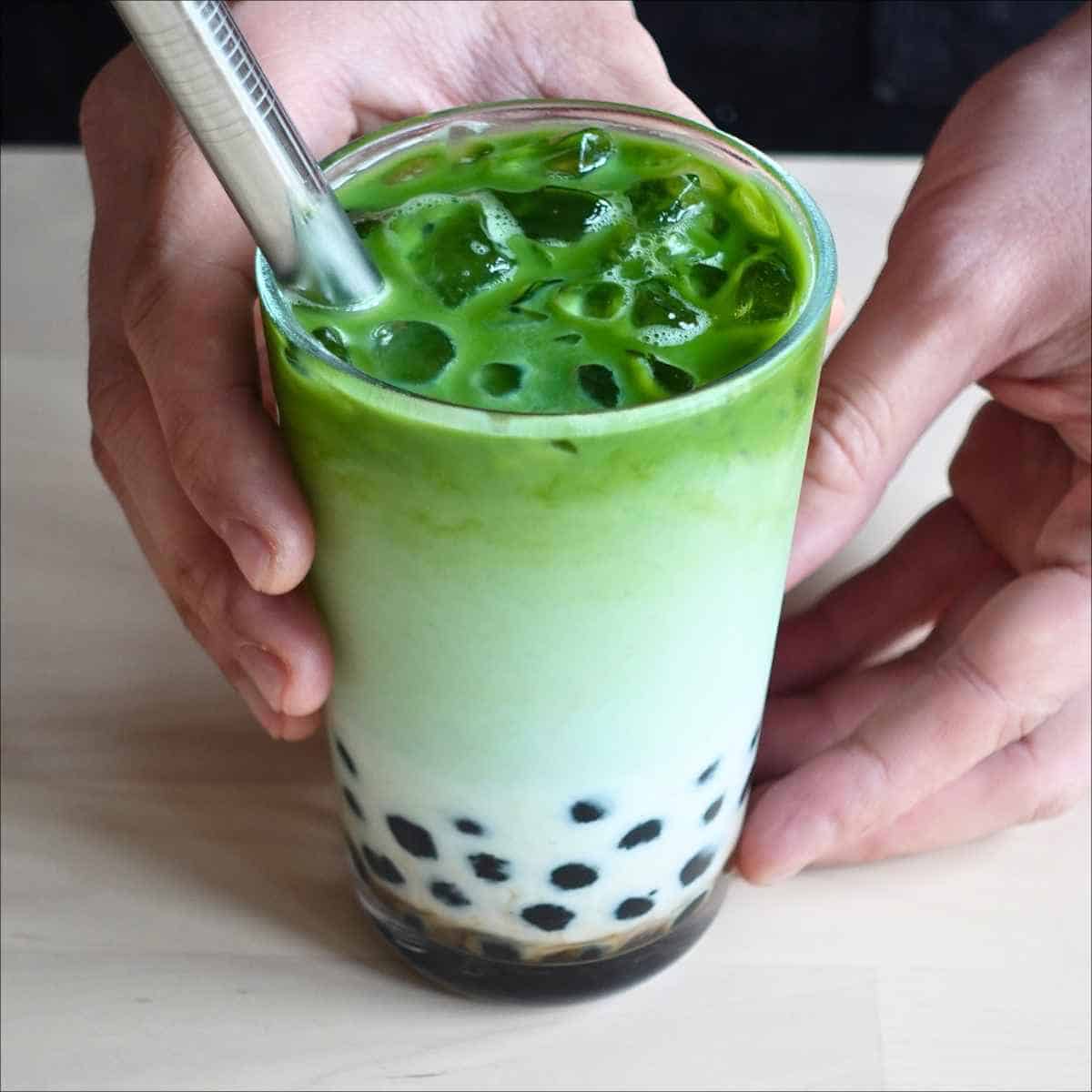
If you prefer it cold, you can add a few ice cubes. However, we wouldn’t recommend storing this in the fridge beforehand for the same reasons we mentioned earlier.
Usually, when we want to enjoy Japanese green tea cold, we would use less water to whisk it together. This results in a thicker consistency which we would then add cold water to. This way, we don’t add ice cubes that would dilute the drink over time.
How to drink and serve Japanese green tea
A traditional Japanese tea ceremony serves this warm drink in a chawan (tea bowl) with a small sweet known as wagashi. After making matcha, you then need to pass the bowl to the guest. The guest should turn it clockwise twice. Then they take a sip and appreciate the flavours. After that, they drink the rest.
If you make matcha at home, you can enjoy it hot, warm, or iced. The way you drink it depends on personal preference. However, we will insist that it's best you drink it soon after you’ve made it. You’ll be able to enjoy its frothiness and full earthy flavour.
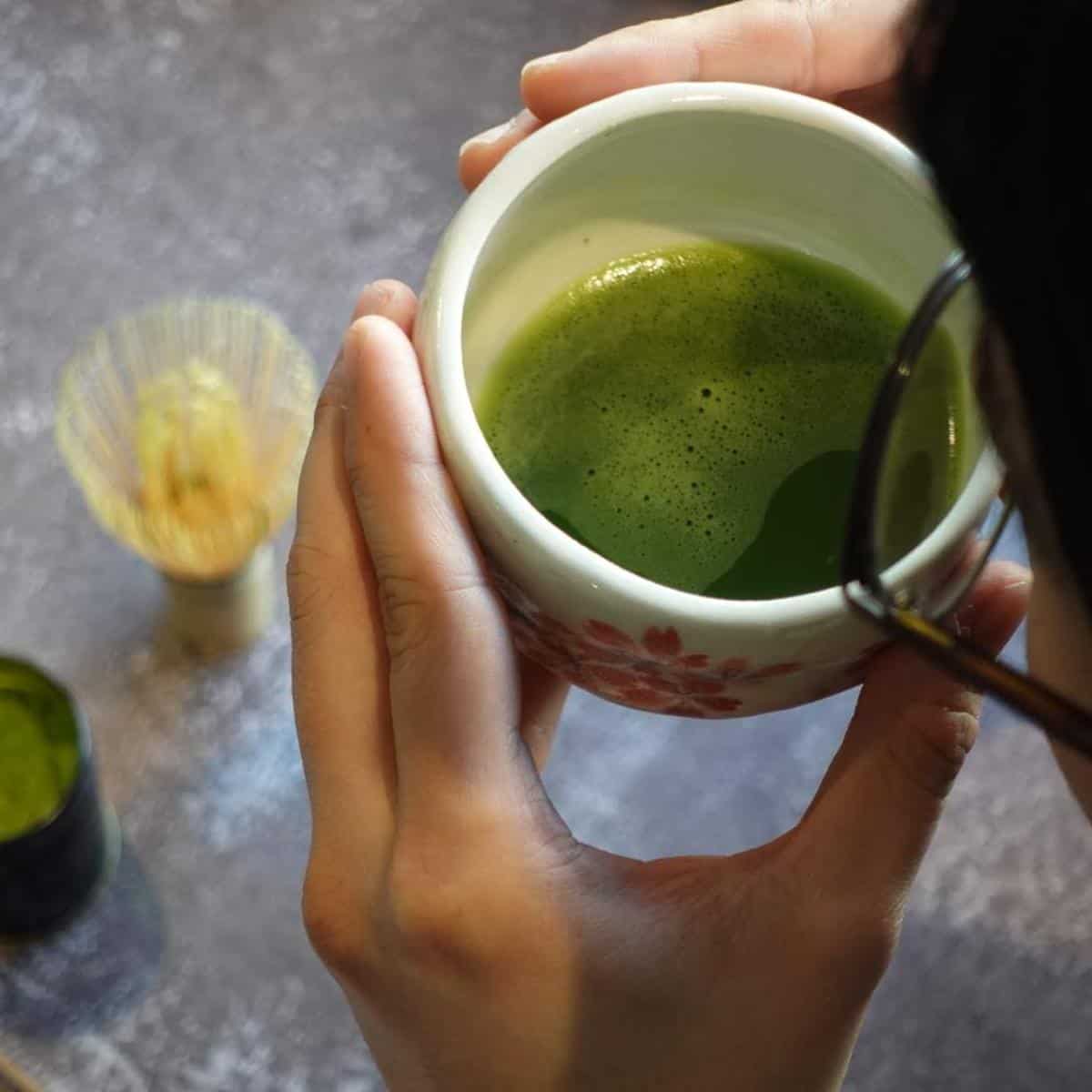
When you make matcha green tea, the key thing is to slow down. We like to think of the whole process as an experience. From preparation to sipping, do it slowly, and you’ll fully appreciate its unique taste and aroma.
You can enjoy the drink independently. We love to pair it with light Japanese snacks such as rice crackers or traditional Japanese sweets like mochi or manju.
Matcha vs green tea
There has always been confusion between matcha vs green tea. Matcha is explicitly grown, so the leaves turn a darker green and generate more amino acids than regular green tea.
The stem and veins of the leaves are removed before they are stone-ground to make the powder. Because of its strong flavour, Japanese people don't usually take a lot of it at once. Especially overseas, it is frequently diluted in milk and drunk as a latte, in contrast to green tea, which is typically steeped in hot water.
Health benefits
According to medical experts from Healthline, Japanese green tea has natural antioxidants that protect your immune system. It also contains caffeine which can help improve brain function and increase alertness.
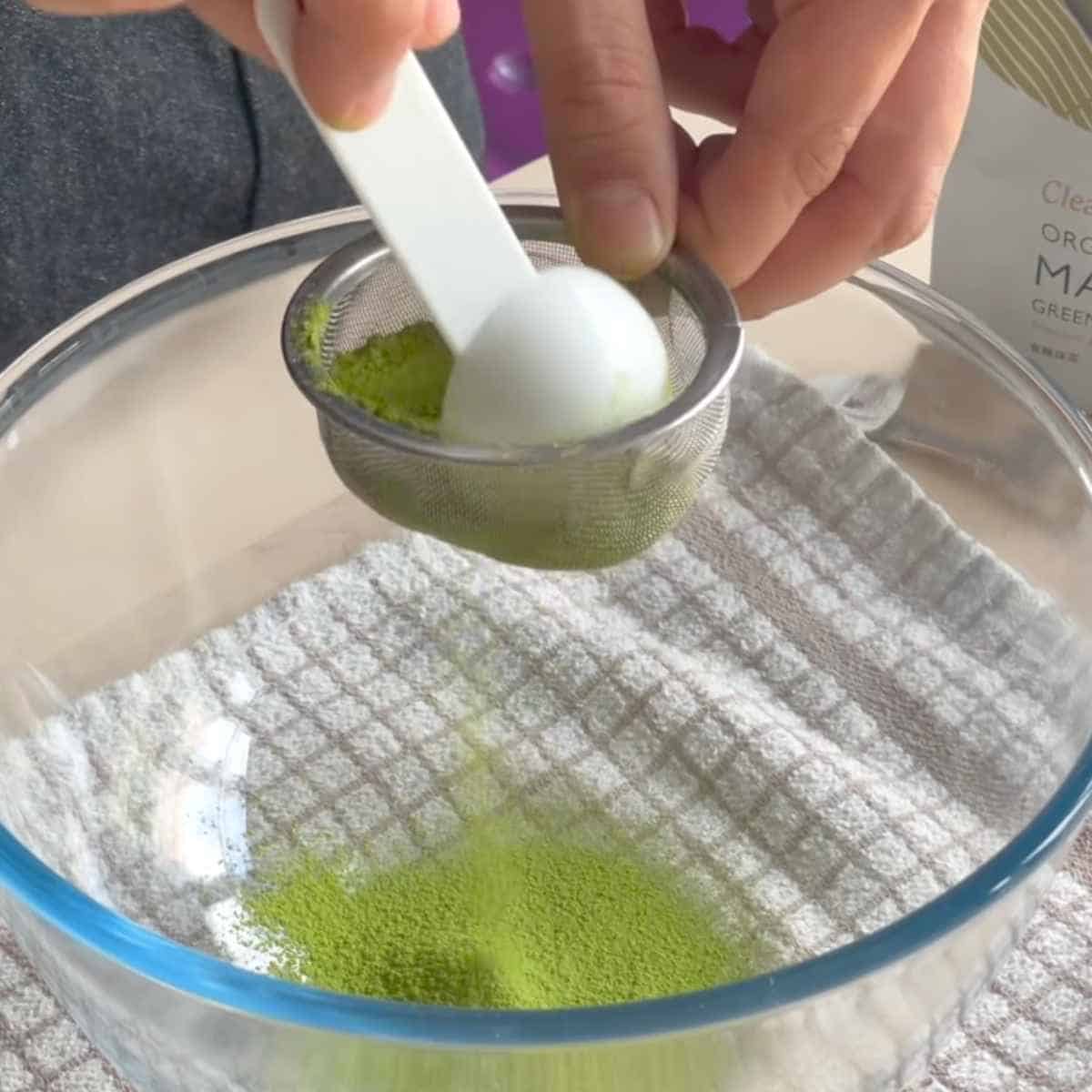
Matcha powder contains less caffeine than coffee. A cup of coffee contains about 100-140mg of caffeine, while a cup of green tea contains about 70mg. However, the caffeine content varies based on the type of leaves. It also depends on how much powder you use to make green tea and the brewing time.
If you’re looking for a quick energy boost, most people will go for a cup of coffee. However, matcha is a better choice than coffee if you're looking for a drink to give you sustained energy throughout the day. It will not give you the jitters and crashes that come with coffee.
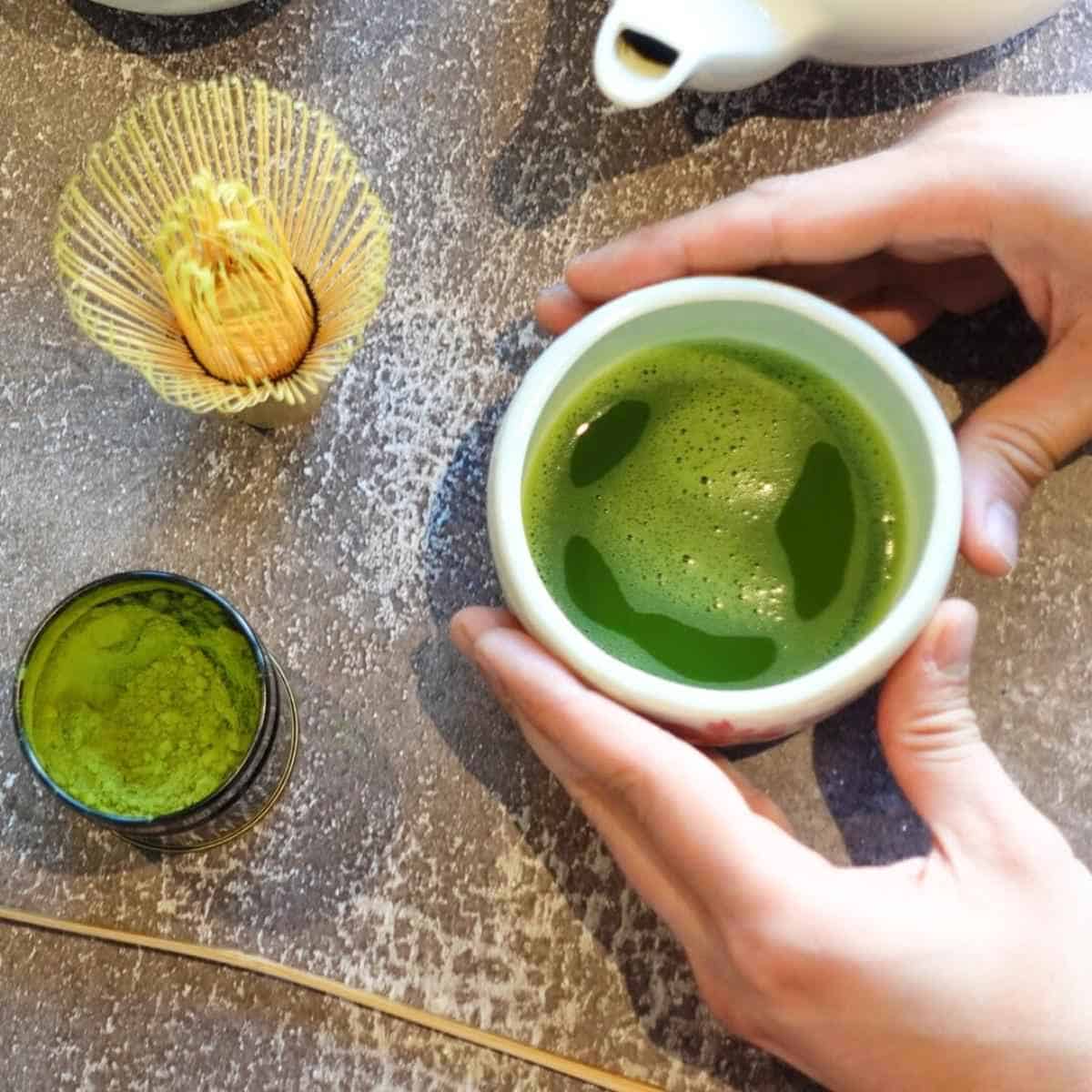
According to dental experts, matcha is less likely to stain your teeth compared to other types of teas.
What does matcha taste like?
Matcha tea has a pleasant grassy flavour, a hint of bitterness, and natural sweet nuttiness. In addition, it has an excellent savoury taste known as umami, making drinking matcha enticing.
We hope you have enjoyed brewing our Japanese green tea recipe. This versatile ingredient can be used in various recipes.
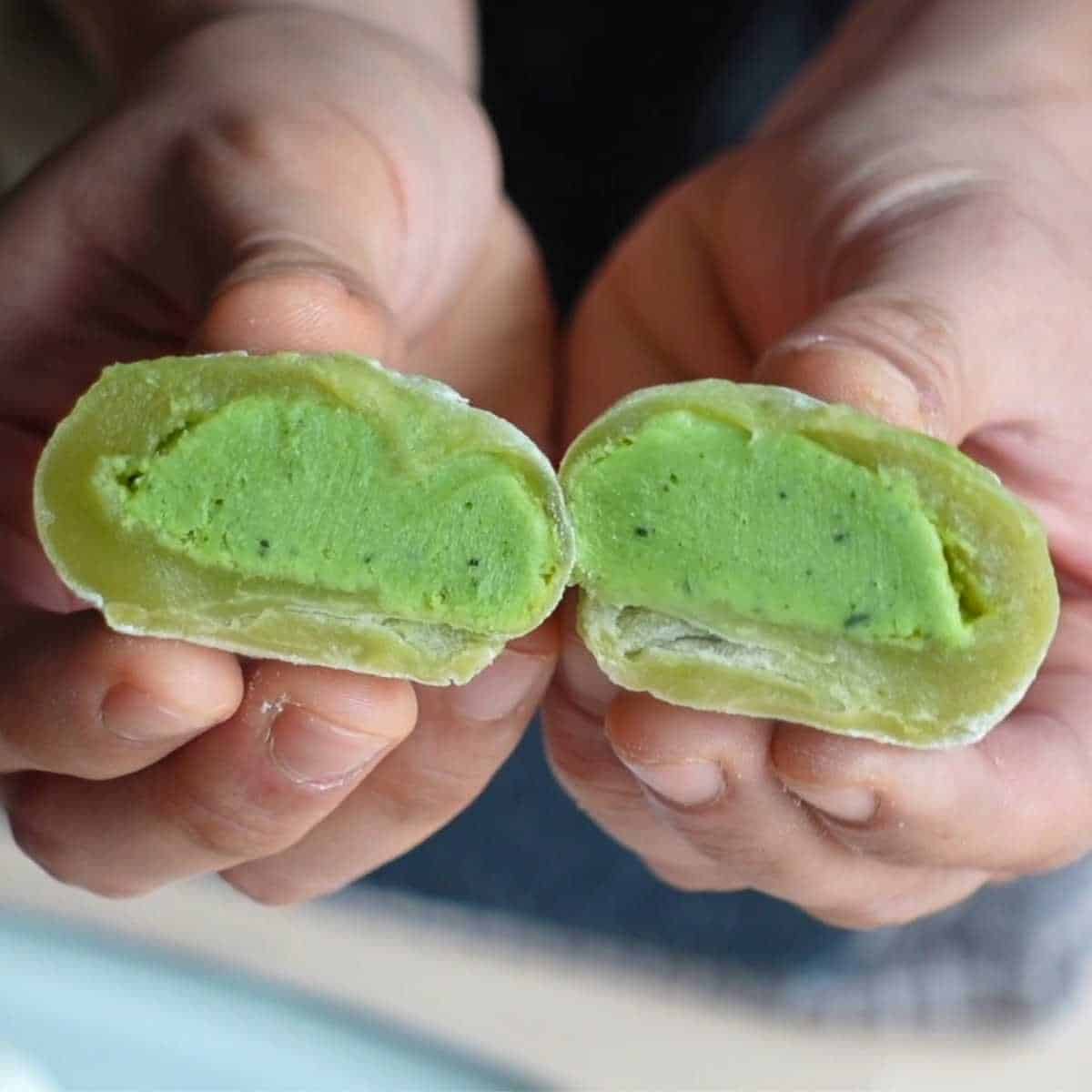
Other than using it in traditional tea, you can try making lattes, a matcha smoothie, and even lemonade with it. There are many variations of matcha powder recipes.
You can also get creative and add it to some of your favourite treats like tiramisu, cheesecake and green tea crepe cake. Its unique flavour and numerous health benefits make it an excellent addition to any kitchen.

Leave a Reply